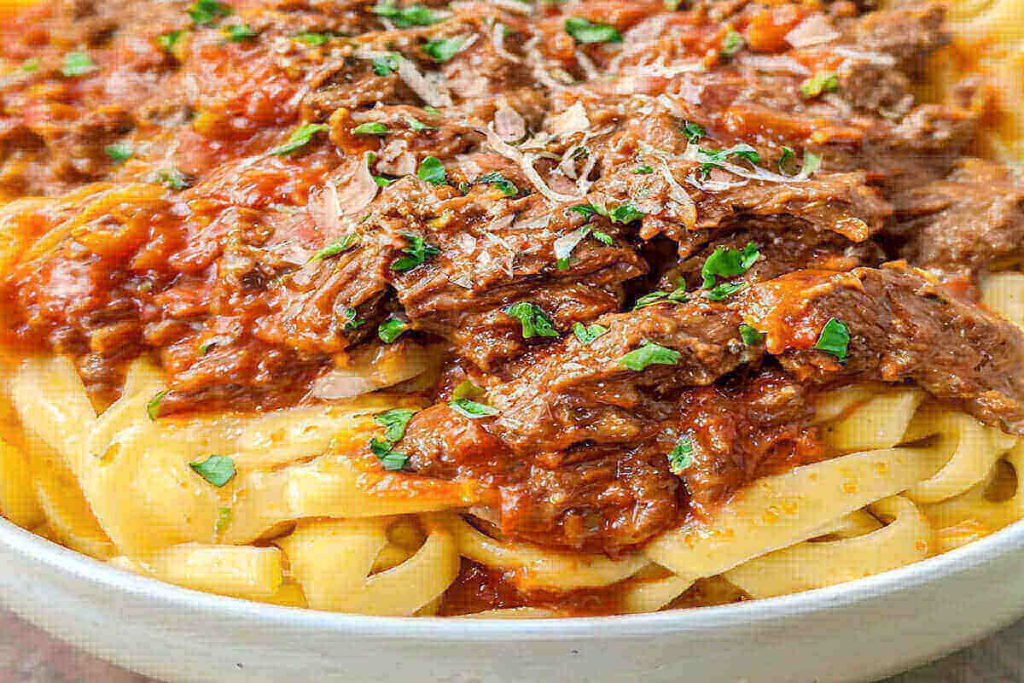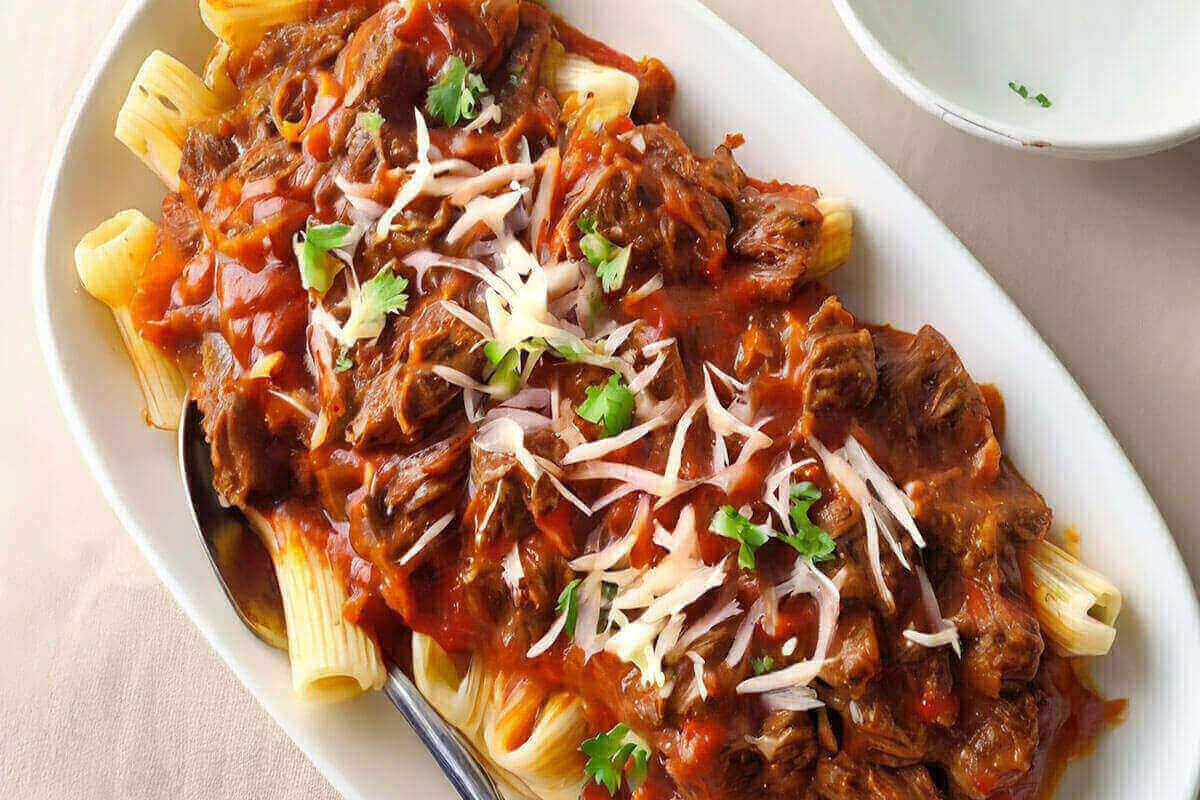Slow cooker bison ragu is a delightful twist on the classic Italian dish. It combines the hearty flavors of a slow-cooked meat sauce with the lean, nutritious goodness of bison meat. Perfect for busy weeknights or special occasions, this dish offers a comforting, healthy alternative to traditional beef or pork-based ragus. With its rich texture and savory taste, this recipe will quickly become a household favorite.
Understanding Bison Ragu
What Is Bison Ragu?
Bison ragu is a flavorful Italian-inspired meat sauce typically served over pasta. While traditional ragus often use beef or pork, this version uses bison, a lean and tender meat that’s both delicious and nutritious. The term “ragu” refers to a meat-based sauce that’s slow-cooked with vegetables, tomatoes, and seasonings, creating a thick and savory dish.
Interestingly, ragu has a deep-rooted history in Italian cuisine, originating as a hearty meal for farmers. Over time, its versatility and satisfying taste made it a staple worldwide.
Unique Features of Bison as a Protein
Bison meat stands out for several reasons. It’s leaner than beef, making it a healthier option for those looking to reduce fat intake. Additionally, it has a mildly sweet, tender flavor that enhances the overall taste of the ragu. Unlike beef, bison is often pasture-raised, which contributes to its nutritional profile and sustainability.
Why Bison Is a Great Alternative to Beef or Pork
If you’re looking for a protein-packed alternative to traditional meats, bison is a fantastic choice. It has fewer calories and less fat while still delivering a rich, satisfying flavor. Plus, its environmental impact is lower than conventionally farmed meats, making it a great option for eco-conscious eaters.
Nutritional Benefits of Bison Meat
One of the main reasons to try slow cooker bison ragu is its health benefits. Compared to beef, bison contains significantly less fat and calories. For example, a 3-ounce serving of bison has around 2.5 grams of fat, compared to 8.5 grams in beef. It’s also an excellent source of protein, providing essential amino acids that support muscle growth and repair.
Moreover, bison is rich in omega-3 fatty acids, which promote heart health, and it contains vital nutrients like iron, zinc, and vitamin B12. These elements help boost energy levels and support overall well-being.
Learn more about nutritious meals like Escarole and Beans Recipe: A Healthy Italian Delight.
For more on bison’s benefits, explore the National Bison Association’s resource on bison meat.
Preparing the Perfect Bison Ragu
Essential Ingredients for Slow Cooker Bison Ragu
To create the perfect slow cooker bison ragu, you’ll need a mix of wholesome, flavorful ingredients:
- Bison Meat
- Choose ground bison or bison stew meat. Its lean texture absorbs the sauce beautifully and becomes incredibly tender after slow cooking.
- Vegetables
- A classic mix of onions, carrots, and celery (known as a soffritto) forms the flavor base. Add garlic for extra depth.
- Tomato Base
- Crushed tomatoes, tomato paste, or marinara sauce provide a rich, hearty consistency. Go for organic or low-sodium options if preferred.
- Herbs and Spices
- A mix of basil, oregano, thyme, and bay leaves adds authentic Italian flavor. You can also sprinkle red chili flakes for a subtle kick.
- Additional Ingredients
- Use beef broth or vegetable stock for liquid. Olive oil enhances richness, while Parmesan cheese or nutritional yeast can add umami if desired.
Ingredient Variations for Dietary Preferences
- Gluten-Free: Ensure your broth and tomato products are certified gluten-free. Serve over gluten-free pasta or spiralized zucchini.
- Paleo: Skip cheese and opt for fresh herbs. Serve with roasted vegetables or cauliflower rice.
- Low-Carb: Use spaghetti squash or shirataki noodles as a base.
Step-by-Step Slow Cooker Instructions
1. Prepare Your Ingredients
Dice the vegetables finely for an even texture. Season the bison with salt and pepper.
2. Sauté for Extra Flavor
In a skillet, heat a little olive oil. Sauté the vegetables until softened, about 5 minutes. Add garlic and cook briefly. Then, brown the bison on all sides to lock in flavor.
3. Layer in the Slow Cooker
Add the sautéed vegetables, browned bison, tomato base, and broth into the slow cooker. Toss in your herbs and spices.
4. Cook Low and Slow
Set your slow cooker to low heat and cook for 6-8 hours. This slow process allows the flavors to meld and the bison to become tender.
5. Final Touches
Stir the sauce well and adjust the seasoning before serving. If it’s too thick, add a splash of broth. For a thicker sauce, remove the lid during the last 30 minutes of cooking.
Tips for Maximizing Flavor
Fresh vs. Dried Herbs
Fresh herbs like basil and parsley offer a vibrant flavor, while dried herbs deliver a deeper, more concentrated taste. A combination of both works best.
Alternative Liquids
Beef broth adds richness, but you can try vegetable stock or even pomegranate juice for a hint of sweetness. Avoid water, as it dilutes the flavor.
Adjusting Seasoning
Taste throughout the cooking process. Add salt, pepper, or even a dash of balsamic vinegar to balance the acidity of the tomatoes.
Discover more slow-cooked dishes like Boneless Beef Ribs in Oven: Tender and Flavorful Recipes.
For slow cooker tips, check out The Kitchn’s guide to slow cooking.
Serving and Pairing Ideas
How to Serve Slow Cooker Bison Ragu
One of the best things about slow cooker bison ragu is its versatility. This hearty dish pairs beautifully with many bases and can be presented in both traditional and creative ways.
Traditional Pairings
- Pasta: Opt for long, wide noodles like tagliatelle or fettuccine, which soak up the rich sauce perfectly.
- Rice: Serve the ragu over a bed of white rice, brown rice, or even wild rice for a nutty flavor.
- Mashed Potatoes: Creamy mashed potatoes offer a comforting, classic option that balances the bold taste of the ragu.
Creative Serving Ideas
- Stuffed Vegetables: Scoop the ragu into hollowed-out bell peppers or zucchinis, then bake for an eye-catching dish.
- Polenta: Spread creamy polenta onto a plate and ladle the ragu over it for a rustic, restaurant-worthy presentation.
- Ragu Bowls: Build a hearty meal with layers of ragu, steamed greens, and roasted sweet potatoes for a healthy twist.
Perfect Side Dishes
Complement your slow cooker bison ragu with these delicious sides for a complete meal:
1. Salads
- A simple arugula salad with lemon vinaigrette adds brightness and cuts through the richness of the ragu.
- Kale and pomegranate salad provides crunch and a sweet contrast.
2. Garlic Bread
- Warm, crusty garlic bread is the perfect vessel for soaking up extra sauce. You can also try cheesy breadsticks for a fun variation.
3. Roasted Vegetables
- Roasted carrots, zucchini, or Brussels sprouts enhance the meal with a caramelized sweetness.
Beverages to Complement the Dish
Pairing beverages with bison ragu enhances the dining experience. Non-alcoholic options include:
- Sparkling Water with Lemon: Light and refreshing, it cleanses the palate between bites.
- Iced Herbal Tea: A subtle, fruity tea like hibiscus or peach complements the savory flavors.
- Apple Cider (Non-Alcoholic): Adds a sweet and tangy element that pairs well with the tomato-based sauce.
Pair your meal with ideas from Escarole and Bean Soup: A Delicious and Healthy Recipe.
For polenta inspiration, explore BBC Good Food’s guide to making polenta.
Troubleshooting and Storage Tips
Common Mistakes to Avoid
Cooking a perfect slow cooker bison ragu requires attention to detail. Here are some pitfalls to steer clear of:
1. Overcooking or Under-Seasoning Bison
Bison is a lean meat, and overcooking can lead to dryness. Stick to the recommended cooking time of 6–8 hours on low heat to ensure tender, juicy results. Additionally, under-seasoning can leave the dish bland. Taste-test and adjust salt, pepper, and herbs throughout the process to maintain balance.
2. Using the Wrong Slow Cooker Settings
While high heat might seem like a time-saver, it can cause the ragu to burn or over-reduce. Always use the low heat setting to allow the flavors to meld and the bison to cook gently.
Storage and Reheating
Proper storage ensures that your slow cooker bison ragu remains flavorful and safe to eat.
1. How to Store Leftovers for Maximum Freshness
- Allow the ragu to cool to room temperature before storing.
- Transfer to airtight containers to prevent contamination.
- Store in the refrigerator for up to 4 days.
2. Reheating Methods to Preserve Flavor and Texture
- On the Stovetop: Heat the ragu over medium-low heat, stirring occasionally, until warmed through. Add a splash of broth or water if it appears too thick.
- In the Microwave: Heat in short intervals, stirring in between, to evenly distribute the heat.
3. Tips for Freezing Ragu for Future Meals
- Portion the ragu into freezer-safe containers or zip-top bags for easy thawing.
- Lay the bags flat in the freezer for efficient storage.
- Ragu can be frozen for up to 3 months. When ready to use, thaw it overnight in the fridge and reheat gently.
For more hearty recipes, check out Salisbury Steak Recipe with Onion Soup Mix: Easy & Delicious.
For safe food storage tips, visit the USDA’s Food Safety Guidelines.
FAQs About Slow Cooker Bison Ragu
What Makes Bison Meat Different From Beef?
Taste and Texture Comparison
Bison meat is leaner and slightly sweeter than beef, with a tender yet hearty texture. It has a cleaner, less gamey flavor, which makes it ideal for slow cooking as it absorbs seasonings beautifully. Unlike beef, bison is often grass-fed and pasture-raised, resulting in a healthier, more sustainable protein option.
Can I Substitute Ground Bison for Bison Chunks?
Adaptations for Different Meat Cuts
Absolutely! Ground bison works well for a smoother, cohesive sauce, while bison chunks create a chunkier, stew-like texture. If using ground bison, reduce the browning time slightly to avoid overcooking. For bison chunks, ensure you brown them thoroughly to lock in flavor before slow cooking.
What Spices Go Well with Bison?
Herb and Spice Pairings
Bison pairs wonderfully with classic Italian herbs like oregano, basil, and thyme. For added depth, try rosemary or bay leaves. A pinch of smoked paprika or chili flakes can enhance the dish with a hint of warmth. To brighten the flavors, a sprinkle of freshly chopped parsley at the end is ideal.
How Do I Make This Recipe Gluten-Free or Paleo?
Substitution Recommendations
- Gluten-Free: Ensure all canned goods and broths are labeled gluten-free. Swap traditional pasta for gluten-free options or serve the ragu over rice or mashed potatoes.
- Paleo: Skip Parmesan cheese and opt for nutritional yeast for a cheesy flavor. Replace pasta with zoodles (zucchini noodles) or roasted vegetables. Choose bone broth for added nutrients.
What Other Meats Can I Use If Bison Isn’t Available?
Options Like Venison, Elk, or Lamb
If bison is unavailable, venison and elk are excellent substitutes with similar leanness and flavor profiles. Lamb provides a richer, slightly gamey taste that works well in ragu. For a more common alternative, lean ground turkey or chicken can also be used, though the flavor will differ slightly.
Explore another hearty option with French Onion Soup: Calories, Nutritional Breakdown, & Health Tips.
For a deeper dive into bison’s health benefits, visit the National Institutes of Health’s page on lean protein sources.


